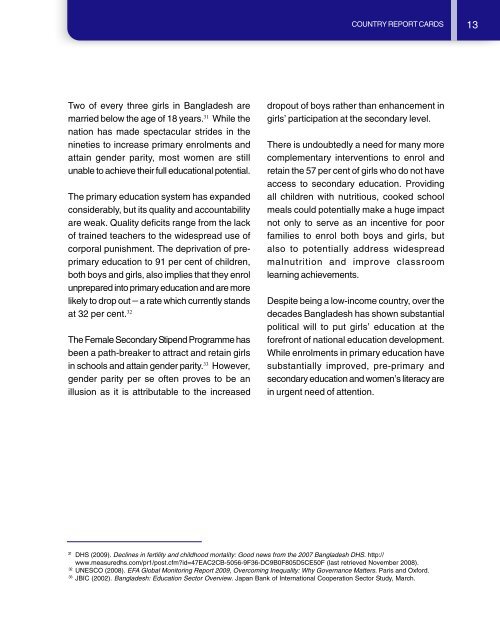Cover(final) - United Nations Girls' Education Initiative
Cover(final) - United Nations Girls' Education Initiative
Cover(final) - United Nations Girls' Education Initiative
You also want an ePaper? Increase the reach of your titles
YUMPU automatically turns print PDFs into web optimized ePapers that Google loves.
COUNTRY REPORT CARDS 13<br />
Two of every three girls in Bangladesh are<br />
married below the age of 18 years. 31 While the<br />
nation has made spectacular strides in the<br />
nineties to increase primary enrolments and<br />
attain gender parity, most women are still<br />
unable to achieve their full educational potential.<br />
The primary education system has expanded<br />
considerably, but its quality and accountability<br />
are weak. Quality deficits range from the lack<br />
of trained teachers to the widespread use of<br />
corporal punishment. The deprivation of preprimary<br />
education to 91 per cent of children,<br />
both boys and girls, also implies that they enrol<br />
unprepared into primary education and are more<br />
likely to drop out − a rate which currently stands<br />
at 32 per cent. 32<br />
The Female Secondary Stipend Programme has<br />
been a path-breaker to attract and retain girls<br />
in schools and attain gender parity. 33 However,<br />
gender parity per se often proves to be an<br />
illusion as it is attributable to the increased<br />
dropout of boys rather than enhancement in<br />
girls’ participation at the secondary level.<br />
There is undoubtedly a need for many more<br />
complementary interventions to enrol and<br />
retain the 57 per cent of girls who do not have<br />
access to secondary education. Providing<br />
all children with nutritious, cooked school<br />
meals could potentially make a huge impact<br />
not only to serve as an incentive for poor<br />
families to enrol both boys and girls, but<br />
also to potentially address widespread<br />
malnutrition and improve classroom<br />
learning achievements.<br />
Despite being a low-income country, over the<br />
decades Bangladesh has shown substantial<br />
political will to put girls’ education at the<br />
forefront of national education development.<br />
While enrolments in primary education have<br />
substantially improved, pre-primary and<br />
secondary education and women’s literacy are<br />
in urgent need of attention.<br />
31<br />
DHS (2009). Declines in fertility and childhood mortality: Good news from the 2007 Bangladesh DHS. http://<br />
www.measuredhs.com/pr1/post.cfm?id=47EAC2CB-5056-9F36-DC9B0F805D5CE50F (last retrieved November 2008).<br />
32<br />
UNESCO (2008). EFA Global Monitoring Report 2009, Overcoming Inequality: Why Governance Matters. Paris and Oxford.<br />
33<br />
JBIC (2002). Bangladesh: <strong>Education</strong> Sector Overview. Japan Bank of International Cooperation Sector Study, March.

















